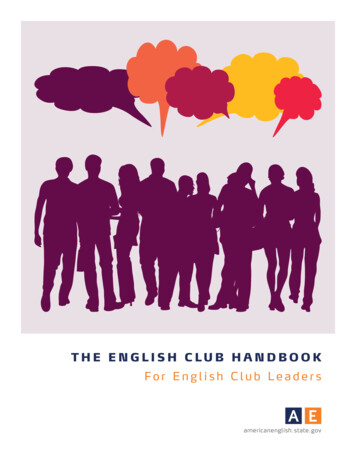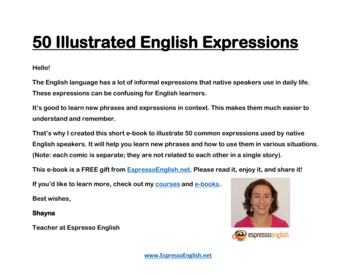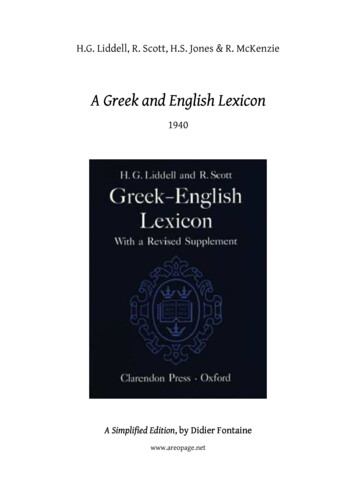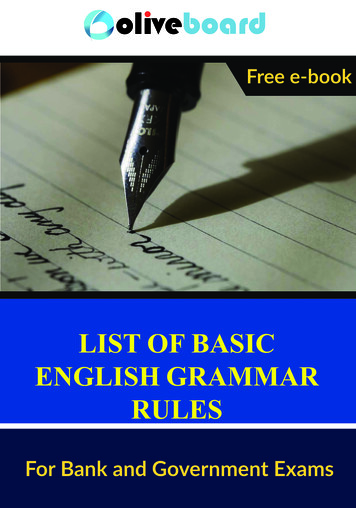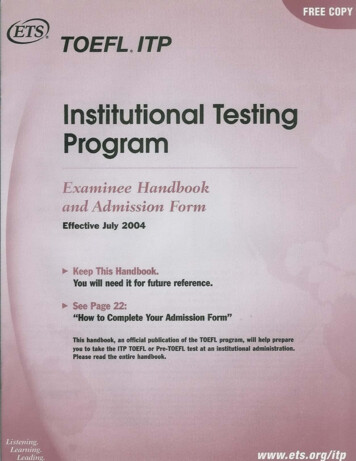
Transcription
Test of English as a Foreign LanguageInstitutional Testing ProgramP0 Box 6155Princeton, NJ 08541-6155, USAWeb site: wwwAoefl.orgEmail address: itp@ets.orgThe Test of English as a Foreign Language (TOEFL) and Pre-TOEFL are examinations given according to procedures designed to protect theirsecurity before, during, and after their administration. The Examinee Handbook, a copy of which is given free to each person who is scheduled totake either test under the Institutional Testing Program, will help individuals prepare for the tests. The only official study materials issued by theTOEFL program for ITP TOEFL are this Handbook, the TOEFL Sample Test (6th edition), the TOEFL Test Preparation Kit, and TOEFL PracticeTests (Volume 2). For ITP Pre-TOEFL, the only official study materials are this Handbook, Understanding TOEFL, Listening to TOEFL, Readingfor TOEFL, and the Sample Test (4th edition). For information about the study materials, see page 21.The TOEFL program does not operate, license, endorse, or recommend any schools or study materials that claim to prepare people for TOEFLor Pre-TOEFL in a short time or that promise them high scores on the tests.Educational Testing Service (ETS) is a sponsor of TOEFL and administers the tests under the general direction of a board that was establishedby, and is affiliated with, the College Board and the Graduate Record Examinations Board.Educational Testing Service is an Equal Opportunity/Affirmative Action EmployerCopyright 2004 by Educational Testing Service. All rights reserved.No part of this publication maybe reproduced or transmitted in any form or by any means,electronic or mechanical, including photocopy, recording, or any information storage and retrieval system,without permission in writing from Educational Testing Service, Princeton, NJ, USA.EDUCATIONAL TESTING SERVICE, ETS, the ETS logos, TOEFL, and the TOEFL logo are registered trademarks of Educational Testing Service
CONTENTSImportant Note3General Information3Procedures at the Place of Testing334What You Will Need at the Place of TestingCheating/Unacceptable BehaviorPreparing for and Taking the TestHow to Complete Your Answer SheetExample: Part of Tomiko Saito’s Answer SheetSample Answer Sheet4456ITP TOEFL Practice Questions7Pre-TOEFL Practice Questions12Answer Spaces for the Practice Questions17Score Records18181818Examinee Requests for Cancellation of ScoresScore Cancellation by the Test SupervisorScore Cancellation by the ITP OfficeUnderstanding Your ITP ScoresHow Your Scores Are ReportedScores Obtained on Different Editions of the TestAcceptable ScoresInterpreting Your ITP TOEFL ScoresInterpreting Your Pre TOEFL Scores181818191920ITP TOEFL Study Materials21Pre-TOEFL Study Materials21How to Complete Your Admission Form22Answer Key for Practice Questions22Region and Native Country Codes/Native Language Codes23Admission Forminside back cover
IMPORTANT NOTEThis handbook contains information about the Institutional Testing Program TOEFL (Test of English as a Foreign Language)and Pre-TOEFL (Preliminary TOEFL) tests. Your instructor win tell you which of these tests you tests take. Because ITI’TOEFL and Pre-TOEFL are similar you should read carefully the description of the tests and the procedures to be followed inthe testing room on the day of the test The practice questions on pages 9-19 are samples of the types of questions you willencounter when you take either test Although actual test questions will be similar to the practice questions, they will vary indifficultyGeneral InformationThe purpose of the ITP TOEFL and Pre-TOEFL tests is toevaluate the English proficiency of people whose nativelanguage is not English. Each test uses a multiple-choiceformat to measure the ability to understand North AmericanEnglish. The ITP TOEFL test is given in a single session ofabout two and a half hours, which includes the time requiredfor completing admission procedures. ITP Pre-TOEFLrequires about one and a half hours. Both tests consist ofthree sections: Listening Comprehension—Measures ability to understandEnglish as it is spoken in North America. Structure and Written Expression—Measures ability torecognize language that is appropriate for standard writtenEnglish. Reading Comprehension—Measures ability to understandnontechnical reading matter. (FFP Pre-TOEFL contains aseparate Vocabulary subsection. See page 17.)Scores obtained at an ITP administration are reported onlyto the institution administering the test, Students who needTOEFL scores for admission to universities and collegesmust take the TOEFL test at a TOEFL paper/pencil orcomputer-based administration. Test in the ITP programare NOT to be administered for admissions purposes.If you need official TOEFL scores for admission to acollege or university, you should register to take the officialTOEFL test. Online information is available through theTOEFL Web site (www.ets.org/toefl).You may download or order an Information andRegistration Bulletin for the TOEFL testing program byvisiting the Web site at www.ets.org/toefl or by writing to:Test of English as a Foreign LanguageP0 Box 6151Princeton, NJ 08541-6151, USAYour admission form is inside the back cover of thisExaminee Handbook. You must complete the form accordingto the directions given on page 22. After you have completedthe form, put it in a safe place; you will need it when youtake the test. Before the test begins, you will have to copyinformation from your admission form onto your answersheet.Procedures at the Place of TestingThe ITP TOEFL or Pre-TOEFL test is given in one session onthe date and at the time and place shown on your admissionform, or as announced by your teacher or by an official of theinstitution administering the test. You must report to testingroom on time. Although the actual testing time is less than twohours, extra time is required for admitting examinees,completing information on answer sheets, and distributing andcollecting test materials.NO ONE WILL BE ADMITTED TO THE TESTINGROOM AFFER THE TEST HAS BEGUN.You should not take chewing gum, candy, or any otherfood into the testing room. No disturbing noises will bepermitted while the test is being given. Cellular phones andbeepers must be turned off. There will be no rest break beforeor during the test administration.Unless you are personally known to the test supervisor,you must present official identification to be admitted to thetesting room. Read the following information carefully soyou will understand what identification you must have.What You Will Need at the Place of TestingWhen you go to the testing room, you must take yourcompleted admission form, your identification document, andseveral sharpened pencils.Admission Form. You must take your completed admissionform. If it is not completed, it may cause you considerabledelay. Directions for completing the admission form are onpage 22.Identification Document. If you take the test outside yourcountry, you must present your passport containing yoursignature arid a recognizable photograph. (This means thatyou must look like the picture in your passport.) Otheridentification will not be accepted.If you take the test within your country, you may presentyour passport containing your signature and a recognizablephotograph, if you have one. If you do not have a passport,you may present a letter verifying your identity (and writtenon the school’s letterhead stationery) from an official of theschool you attend or most recently attended. The letter musthave your photograph glued to it, and the title, signature, andseal of the official who issued the letter of identification mustoverlap the photograph, as shown on page 4.NO OTHER FORMS OF IDENTIFICATION WILL BEACCEPTED.Note to Individuals Without Acceptable Identification:If you do not have acceptable identification, you will not beadmitted to the testing room, If you insist on taking the testwithout the required identification, your scores will becanceled.Pencils and Erasers. You must take several sharpened,medium-soft (#2 or HB), black lead pencils. You may not usea pen, a pencil with colored lead, or a liquid lead pencil tomark your answer sheet. You will also need a good-quality
If you present an official letter as an identification document, it must look like this.eraser that will completely erase any unintended marks youmake on your answer sheet. Pencils and erasers will not besupplied by the test supervisor.Watch. You may take a watch. However, watch alarms,including those with flashing lights or alarm sounds, are notpermitted.Lunch. There is no lunch break during the test. You will notbe permitted to take gun, candy, food, or beverages into thetesting room.NOTE: You may not take books, dictionaries, recording andphotographic devices, or note papers of ally kind into thetesting room.Cheating/Unacceptable BehaviorThe test supervisor may cancel the scores of anyone who: takes a test book or answer sheet from the testing room.Test materials are the property of the Institutional TestingProgram office. attempts to take the test for someone else. gives or receives assistance during the test. fails to follow instructions given by the test supervisor. reads or works on one section of the test during the timeallowed for another, or continues to work after time iscalled. makes any marks or underlines words in the test book ormakes notes in the test book or on the answer sheet. takes dictionaries, other books, notes, or recording orphotographic devices into the testing room. creates a disturbance or behaves inappropriately. copies test questions or answers. cheats in any other way.The ITP TOEFL office will adhere to any instructionsfrom the test supervisor regarding unacceptable behaviordisplayed by examinees.Preparing for and Taking the TestNo single school, textbook, or method of study is best to helpprepare a person for the tests since they are not based on aspecific course of instruction. ITP TOEFL tests are designedto measure a person’s proficiency in English. Stronglanguage proficiency can be achieved only after a relativelylong period of study and practice. An attempt to studyEnglish for the first time shortly before taking the test willprobably not be very helpful.On the day of the test you will read a set of generalinstructions. In addition to the general instructions, eachsection of the test has special directions, including samplequestions. These special directions are very similar to thosegiven for the practice questions in this handbook (see page7). You should become familiar with the special directionsbefore you take the test.Each section of the test has a time limit. The supervisorwill tell you when to start and stop each section. During eachtime period, you may read or work only on the section of thetest you are told to work on. If you finish one section early,you may NOT go on to the next section before you are told todo so, and you may NOT go back to a section you havealready worked on. Failure to follow this rule will beconsidered cheating, and your scores will be canceled (see“Cheating/Unacceptable Behavior”).When you take the test, work rapidly but carefully. Donot spend too much time on any one question. Somequestions are harder than others, but try to answer every one.Your score will be based on the number of questions youanswer correctly. It is to your advantage to answer everyquestion, even if you have to guess. If you think it would behelpful, you may take a watch to the place of testing.You may not use note paper. You may not write or makeany marks in your test book or on your answer sheet. Youwill receive credit only for answers marked in the properplaces.You will find it helpful to study the sample directions andpractice questions on pages 7-17.How to Complete Your Answer SheetWhen you take the test, you will be given an answer sheetlike the one shown on page 6.Identifying Information. It is important that you fill out thisportion of your answer sheet very carefully because theidentifying information youLook at the sample answer sheet on page 6; then read ‘Part ofTomiko Saito’s Answer Sheet” on page 5. Practice filling outthe sample answer sheet according to the instructions giventhere. When you have finished, continue reading the rest ofthis handbook.If you did not write your native country code or nativelanguage code on your admission form, turn to page 24 andfollow the directions for completing these areas on theadmission form. You will not be permitted to use yourExaminee Handbook when you are completing your answer.
EXAMPLE: PART OF TOMIKO SAITO’S ANSWER SHEET211.2.In area 1 (NAME), Tomiko Saito printed her name inthe boxes just as she did on her admission form. Sheprinted her family name first (SAITO), left a spaceblank, then printed her first name (TOMIKO), left aspace blank, then printed her middle initial. Undereach box she filled in the circle corresponding to theletter she placed in that box.In area 2 (STUDENT NUMBER), she copied from heradmission form the student number assigned by herinstitution and then filled in the corresponding circlebeneath each number. (If you are not given a studentnumber, you will leave this area blank.)sheet in the testing roomNOW PRACTICE FILLING IN THE SAMPLE ANSWERSHEET ON PAGE 8. BE SURE TO USE YOURADMISSION FORM WHEN YOU FILL IN THEIDENTIFYINGINFORMATION.Remember,youradmission form contains all the information you will needexcept for areas 6-12. Be sure to take the form to the testingroom on the test date.Responses to Questions. You will mark your answers to thetest questions in areas identified as Section 1, Section 2, andSection 3 on the answer sheet. Each row of four circlescorresponds to the four answer choices for each question;only one of the answer choices is correct. You will not use allof the answer response spaces.The marks you make will be read by an electronic scoringmachine, and the machine can read only one mark in eachrow of four circles. The machine-scoring process is subject tofrequent, careful quality control checks, including scoring byhand a sample of the answer sheets received from eachinstitution. Every effort is made to ensure accurate scoring.3.4.5.3In area 3 (DATE OF BIRTH), she copied her birthdate from her admission form and then filled in thecorresponding circle beneath each number.In area 4 (NATIVE COUNTRY CODE), she copiedthe number she wrote on her admission form and thenfilled in the corresponding circle beneath each number.In area 5 (NATIVE LANGUAGE CODE), she copiedthe number she wrote on her admission form and thenfilled in the corresponding circle beneath each number.However, you are responsible for marking your answer sheetproperly. Follow these directions: Use a medium-soft (#2 or HB) black lead pencil. Be careful to mark the space that corresponds to the answeryou choose for each question. Also, make sure you markyour answer in the row with the same number as thenumber of the question you are answering. You will not bepermitted to make any corrections after time is called. Mark only one answer to each question. Completely fill the circle with a heavy, dark mark so youcannot see the letter inside the circle; light or partial marksmay not be read properly by the machine. Erase any extra marks completely.The examples show you the correct way and wrong waysto mark your answer sheet. Be sure to fill in the circles thecorrect way.
ITP TOEFL Practice QuestionsThe following practice questions and the directions for eachsection are similar to those you will find in the ITP TOEFLand Pre-TOEFL tests. Because the directions are part of thetimed test you should become familiar with them before youtake the test. You will probably get the most benefit from thepractice questions by trying to answer them just as you wouldin the actual test. These questions can also be found atwww.ets.org/toefl.You can get additional practice for ITP TOEFL and PreTOEFL using the official study materials described on page21.Read the questions carefully, and mark your answers inthe spaces provided on page 17. The answer key is on page22, but you should not look at it until you have tried toanswer aid the questions.How to mark your answer sheetLook at the following example.The number of judges on the UnitedStates Supreme Court is determined byCongress—by the Constitution.(A) nevertheless(B) instead(C) despite(D) notThe correct sentence should read, “The number of judgeson the United States Supreme Court is determined byCongress, not by the Constitution.” Therefore, you shouldchoose answer (D). Fill in with your pencil the circle thatcontains a “D”.If you wish to change an answer, completely erase yourfirst answer and fill in your new one.Section 1—Listening ComprehensionThis section is designed to measure the ability to understandspoken North American English. It contains three parts, eachadministered by audio recording.Part ADirections: In Part A, you will hear short conversationsbetween two people. After each conversation, you will hear aquestion about the conversation. The conversations andquestions will not be repeated. After you hear a question,read the four possible answers in your test book and choosethe best answer. Then, on your answer sheet, find the numberof the section and fill in the space that corresponds to theletter of the answer you have chosen.Listen to an example.On the recording, you will hear:(woman) I don’t like this painting very much.(man)Neither do .I(narrator) What does the man mean?In your test book, you will read:(A) He doesn’t like the painting either.(B) He doesn’t know how to paint.(C) He doesn’t have any paintings.(D) He doesn’t know what to do.You learn from the conversation that neither the man nor thewoman likes the painting. The best answer to the question,‘What does the man mean?” is (A), “He doesn’t like thepainting either.” Therefore, the correct choice is answer (A).PRACTICE QUESTIONS1. You will hear:(man)Shall flock up the computer lab now before I gohome?(woman) Don’t bother. I’m not leaving for a while—I cancheck it on my way out.(narrator) What will the woman probably do?You will read: (A) Lock the computer lab later(B) Leave with the man.(C) Buy a new lock for the computer lab.(D) Show the man where the lab is.2. You will hear:(man)Do you mind if I turn the television off?(woman) Well, I’m in the middle of watching a program.(narrator) What does the woman imply?You will read: (A) The man should watch the program(B) The man should leave the televisionon.(C) The program will be over soon.(D) She’ll watch television later.3. You will hear:(woman) I heard the math requirements for graduation arebeing changed.(man)Yes, And I may be short one course.(narrator) What does the man mean?You will read: (A) He isn’t sure what course to take.(B) The math course is too short.(C) He may not meet the graduationrequirements.(D) The graduation date has been changed.Part BDirections: In this part of the test you will hear longerconversations. After each conversation you will hear severalquestions. The conversations and questions will not berepeated.After you hear a question, read the four possible answersin your test book and choose the best answer. Then, on youranswer sheet, find the number of the question and fill in thespace that corresponds to the letter of the answer you havechosen.Remember, you are not allowed to take notes or write inyour test book.
PRACTICE CONVERSATION AN oman)(man)(woman)(man)(woman)(man)Questions 4 through 7. Listen to a conversationabout a trip.Are you ready for ‘The Big Apple”?Excuse me?You know, New York City. You are going toNew York with us, aren’t you? I wanted to showevery body around my old neighborhood.Oh.sure! I wouldn’t miss it— especially whenthe tour guide is a native New Yorker.I thought we could start at the Museum ofModern Art. Right now there’s an exhibit ontwentieth-century Amen can painters.Fine with me but what were you saying about.a big apple?‘The Big Apple.” It’s a nickname for New York.I think I heard once that it started with Jonmusicians in the 20’sOhWhenever they played a concert in a city, theycalled that city an “apple.” In those days, NewYork was the biggest city in the country, so theycalled it “The Big Apple.”Hey, I have an idea! Let’s go to ajaz2 clubwhile we’re there.Sounds good.Questions:4. You will hear:(narrator) What is the man planning to see?You will read: (A) An art exhibit.(B) A Broadway play.(C) A modem dance production.(D) An opera.5. You will hear:(narrator) What can be inferred about the man?You will read: (A) He is a jazz musician.(B) Re wants to join the woman’s club.(C) He is in his twenties.(D) He was born in New York.6. You will hear:(narrator) What does the word “Apple” in the phrase TheBig Apple” refer to?You will read: (A) An instrument.(B) A city.(C) A theater.(D) A concert.7. You will hear:(narrator) Who gave New York its nickname?You will read: (A) Painters.(B) Tour guides.(C) Musicians.(D) Grocers.Part CDirections: In this part of the test you will hear several talks.After each talk, you will hear some questions. The talks andquestions will not be repeated.After you hear a question, read the four possible answersin your test book and choose the best answer. Then, on youranswer sheet, find the number of the question and fill in thespace that corresponds to the letter of the answer you havechosen.Here is an exampleOn the recording, you will hear:(narrator) Listen to an instructor talk to his class about atelevision program.(man)I’d like to tell you about an interesting TVprogram that’ll be shown this comingThursday. It’ll be on from 9 to 20 pm onChannel 4. It’s part of a series called Mysteriesof Human Biology.” The subject of the programis the human brain—how it functions and how itcan malfunction. Topics that will be coveredare dreams, memory, and depression. Thesetopics are illustrated with outstanding computeranimation that makes the explanations easy tofollow. Make an effort to see this show. Sincewe’ve been studying the nervous system inclass, I know you’ll find it very helpful.Now listen to a sample question.(narrator) What is the main.purpose of the program?In your test book, you will read:(A) To demonstrate the latest use ofcomputer graphics.(B) To discuss the possibility of aneconomic depression.(C) To explain the workings of the brain.(D) To dramatize a famous mystery story.The best answer to the question, “What is the main purposeof the program?” is (C), “To explain the workings of thebrain.” Therefore, the correct choice is (C).Here is another example.You will hear:(narrator) Why does the speakerrecommend watching the program?In your test book, you will read:(A) It is required of all science majors.(B) It will never be shown again.(C) It can help viewers improve their memory skills.(D) It will help with course work.The best answer to the question, “Why does the speakerrecommend watching the program?” is (D), “It will help withcourse work.” Therefore, the correct choice is (D).Remember, you are not allowed to take notes or will inyour test book.
PRACTICE TALK AND QUESTIONS(narrator)(woman)Questions 8 through 10. Listen to a talk aboutanimal behavior.Today’s discussion is about a common animalreaction—the yawn. The dictionary defines ayawn as “an involuntary reaction to fatigue orboredom” That’s certainly true for humanyawns, but not necessarily for animal yawns.The same action can have quite differentmeanings in different speciesFor example, some animals yawn to intimidateintruders on their territory. Fish and lizards areexamples of this. Hippos use yawns when theywant to settle a quarrel. Observers have seentwo hippos yawn at each other for as long astwo hours before they stop quarreling.As for social animals like baboons or lions—they yawn to establish the pecking order withinsocial groups, and lions often yawn to calmsocial tensions. Sometimes these animals yawnfor a strictly physiological reason —that is, toincrease oxygen levels. And curiously enough,when they yawn for a physical reason like that,they do what humans do—they try to stifle theyawn by looking away or by covering theirmouths.Questions:8. You will hear:(narrator) What is the speaker’s main point?You will read: (A) Animals yawn for a number of reasons.(B) Yawning results only from fatigue orboredom.(C) Human yawns are the same as those ofother animals.(D) Only social animals yawn.9. You will hear:(narrator)According to the speaker, when arehippos likely to yawn?You will read: (A) When they are swimming.(B) When they are quarrelling.(C) When they are socializing.(D) When they are eating.10. You will hear:(narrator)What physiological reason for yawning ismentioned?You will read: (A) To exercise the jaw muscles.(B) To eliminate fatigue.(C) To get greater strength for attacking.(D) To gain more oxygen.Section 2—Structure and Written ExpressionThis section is designed to measure your ability to recognizelanguage that is appropriate for standard written English.There are two types of Questions in this section, with specialdirections for each type.StructureDirections: Questions 1-4 are incomplete sentences. Beneatheach sentence you will see four words or phrases, marked(A), (B), (C), and (D). Choose the one word or phrase thatbest completes the sentence. Then, on your answer sheet, findthe number of the question and fill in the space thatcorresponds to the letter of the answer you have chosen.Look at the following examples.Example IGeysers have often been compared tovolcanoes they both emit hotliquids from below the Earth’s surface.(A) due to(B) because(C) in spite of(D) regardless ofThe sentence should read, “Geysers have often beencompared to volcanoes because they both emit hot liquidsfrom below the Earth’s surface.” Therefore, you shouldchoose answer (B).Example IIDuring the early period of oceannavigation, —— any need forsophisticated instruments and techniques.(A) so that hardly(B) where there hardly was(C) hardly was(D) there was hardlyThe sentence should read, “During the early period ofocean navigation, there was hardly any need for sophisticatedinstruments and techniques.” Therefore, you should chooseanswer (D).Now begin work on the questions.PRACTICE QUESTIONS1. Refrigerating meats——the spread of bacteria.(A) retards(B) retarding(C) to retard(D) is retarded2. Throughout the animal kingdom, ——bigger than theelephant.(A) whale is only the(B) only the whale is(C) is the whale only(U) only whale is the
3. The fact —— money orders can usually be easilycashed has made them a popular form of payment.(A) of(B) that(C) is that(D) which is4. The first article of the United States Constitution givescongress —— to pass laws.(A) the power(B) has the power(C) the power is(D) of the powerWritten ExpressionDirections: In questions 5-10, each sentence has fourunderlined wor4s or phrases. The four underlined parts of thesentence are marked (A), (B), (C), and (D). Identify the oneunderlined word pr phrase that must be changed in order totthe sentence to be correct. Then, on your answer sheet, findthe number of the question and fill in the space thatcorresponds tote letter of the answer you have chosen.Look at the following examples:Example IGuppies are sometimes call rainbowAfish because of the males’ bright colors.BCDThe sentence should read, “Guppies are sometimes calledrainbow fish because of the males’ bright colors.” Therefore,you should choose answer (A).Example IIServing several term in Congress,ABShirley Chisholm became an importantCUnited States politician.DThe sentence should read, “Serving several terms inCongress, Shirley Chisholm became an important UnitedStates politician.” Therefore, you should choose answer (B).Now begin work on the questions.PRACTICE QUESTIONS5. Electrical disturbances on Earth are frequently causedABwith storms on the surface of the sun.CD6. Inventor Granville Woods received him first patent onABJanuary 3, 1884, for a steam boiler furnace.CD7. A deficient of folic acid is rarely found in humansABbecause the vitamin is contained in a wide variety ofCDfoods.8. The gopher digs with the big strong claws of its two frontABfoot and with its overhanging front teeth.CD9. An internationally famous ballerina, Maria TallchiefAdemonstrated that the quality of ballet in North AmericaBCcould equal those of the ballet in Europe.D10, As two nuclei move closer together, their mutualABelectrostatic potential energy becomes more large andCDmore positive.Section 3—Reading ComprehensionThis section is designed to measure the ability to read andunderstand short passages similar in topic and style to thosefound in North American universities and colleges.Examinees read a variety of short passages on academicsubjects. Each passage is followed by a number of questionsabout the material. To avoid creating an advantage toindividuals in any one field of study, sufficient context isprovided so that no subject-specific familiarity with thesubject matter is required to answer the questions.Directions: In this section you will read several passages.Each one is followed by a number of questions about it. Youare to choose the one best answer, (A), (B), (C), or (D), toeach question. Then, on your answer sheet, find the numberof the question and fill in the space that corresponds to theletter of the answer you have chosen.Answer all questions about the information in a passage onthe basis of what is stated or implied in that passage.
SAMPLE PASSAGE AND QUESTIONSThe railroad was not the first institution to imposeregularity on society, or to thaw attention to theimportance of precise timekeeping. For as long asLine merchants have set out their wares at daybreak and (5)(5) communal festivities have been celebrated, people havebeen in rough agreement with their neighbors as to thetime of day. The value of this tradition is today moreapparent than ever Were it not for public acceptance of asi
TOEFL program for ITP TOEFL are this Handbook, the TOEFL Sample Test (6th edition), the TOEFL Test Preparation Kit, and TOEFL Practice Tests (Volume 2). For ITP Pre-TOEFL, the only official study materials are this Handbook, Understanding TOEFL, Listening to TOEFL, Reading for TOEFL, and the Sample T



